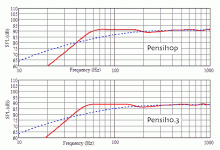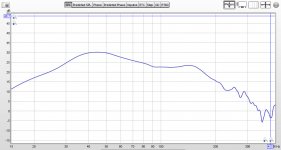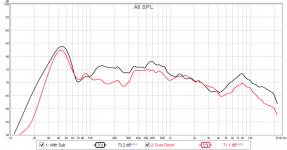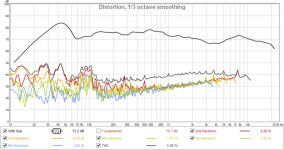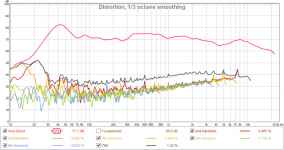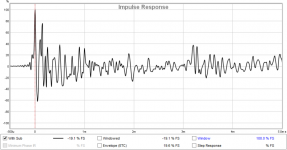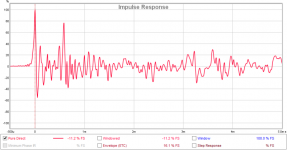If the driver was positioned as high as possible on the side of the enclosure
Then the Zd would be wrong.
dave
Then the Zd would be wrong.
Which I don't understand, which is why we leave the designing up to guys like you and Scott.
I just think the depth of FHXL's footprint is a limiting factor for some people (such as myself). Being able to orient them sideways would make them a real option for me, especially since I have side walls equidistant on both sides of my system.
Monty, from all the opinions I have read on the subject of Alpair 10 enclosures, I gather the FHXL is pretty-much a no-brainer if the physical dimensions are compatible with the user's room and preferences.
Zd is the distance of the driver from the closed end of the pipe. That stub causes a cancelation of the 1st (or in some cases 2nd) undesirable pipe harmonic, allowing oneto get away with less damping and get more bass.
FHXL is a rear mouth horn. Proximity to a wall (or corner) is factored in as part of the bass extension. Turning it sideways would affect that.
dave
FHXL is a rear mouth horn. Proximity to a wall (or corner) is factored in as part of the bass extension. Turning it sideways would affect that.
dave
Zd is the distance of the driver from the closed end of the pipe. That stub causes a cancelation of the 1st (or in some cases 2nd) undesirable pipe harmonic, allowing oneto get away with less damping and get more bass.
Thanks for the explanation!
FHXL is a rear mouth horn. Proximity to a wall (or corner) is factored in as part of the bass extension. Turning it sideways would affect that.
Which is why I think it would work for my room, as it would use the side walls for bass extension rather than the rear wall. I'm imagining that sound stage would be quite wide in this orientation as well. Perhaps it is worth it to play with some foam core and see how it works. Some day...
Last edited:
I'm imagining that sound stage would be quite wide in this orientation as well.
I'm not.
jeff
Mony - while he no longer attends these fora, I think it'd be safe to say that any of Scott's designs would be be modeled to place the driver in the right place to meet his specific target goals. Of course you can put the driver anywhere it'll "fit" on any enclosure, but the likelihood of the result meet the original design brief is significantly reduced.
Somewhere in this thread, the question was posed "best" enclosure for the Alpair10 - there isn't one - several have been listed that work very well, and each trade off some compromises of performance and/or aesthetics / placement.
Unless you have the floorspace, I'd probably go with the Pensils for 10s
Somewhere in this thread, the question was posed "best" enclosure for the Alpair10 - there isn't one - several have been listed that work very well, and each trade off some compromises of performance and/or aesthetics / placement.
Unless you have the floorspace, I'd probably go with the Pensils for 10s
So effectively the Pensils Zd is too low to reduce the odd harmonic resonances?
????
Do you still have the slotted M10-A10? Pics?
It was a build Bernie did for a client. I never got pictures. We added a few of our own enhancements to them.
dave
So Pensil 10s over the M10-A10? What sort of F3/F6/F10 will I be getting with those?
Look at the posted anechoic sims. Add your room, then guess.
dave
I would say that the M10-A10 -- a MLTL for the A10.3 is one of my better efforts. I did build a pair of Pensil's for comparison. There is a fairly significant difference in the tuning of the two boxes. My take is that the M10-A10 is better for classical and girl-and-a-guitar and the P10 better for rock. For what it's worth, my M10-A10's are the mains in my HT setup with a long NLA Peerless 10" sub.
Bob
Bob
Hi there,
Here is another happy Pensil 10.3 user.
Yes 10.3 goes very low (15x15ft room)! After smoothing out two high frequency spikes (5100 and 7800Hz) and tweaking a little baffle step in mid frequencies perceived bass response is superb. I have used 1.5 pounds of Acusta Stuff for filing and some thick felt behind the driver. At 1.1 pounds total (0.4 less stuffing behind driver) will give you 1-2dB more Spl at 100-200Hz at cost of having couple of uncontroled resonances in mid and higher freqencies. Attached nearfield port measurement tells the story about bass extension.
Here is another happy Pensil 10.3 user.
Yes 10.3 goes very low (15x15ft room)! After smoothing out two high frequency spikes (5100 and 7800Hz) and tweaking a little baffle step in mid frequencies perceived bass response is superb. I have used 1.5 pounds of Acusta Stuff for filing and some thick felt behind the driver. At 1.1 pounds total (0.4 less stuffing behind driver) will give you 1-2dB more Spl at 100-200Hz at cost of having couple of uncontroled resonances in mid and higher freqencies. Attached nearfield port measurement tells the story about bass extension.
Attachments
Last edited:
I got an opportunity to take some measurements on my M10-A10 (Alpair 10.3 in a 40" MLTL). The AVR is a Yamaha RX-V665. The sub is a Peerless 850148 in a 3'^3 ported box. The center channel is virtual. The rear's are Fostex FE167E's in ported boxes. The mains and rears are defined as small and the cross-over is set to 150Hz. I ran the automatic setup, then tweaked the EQ, although there are only 6 bands, so it is coarse at best.
The black trace is the Yamaha processed response. The red trace is "Pure Direct", i.e. mains only and no processing. I did not adjust the volume between runs. The "Pure Direct" sounds lower in volume, obviously. The big feature is the 43Hz hump produced by the relatively small room -- 13'x15' and open on one side. It is interesting that the distortion on the low end of the cross-over is higher with the sub on than with the sub off.
Looking at the impulse trace for the "Pure Direct", there are two distinct main pulses. This is because the listening position is slightly off center -- about 1' to the left. The Yamaha has correctly time aligned all five speakers.
OK. The A7.3's in my MLTL have an in-room F3 of 29Hz and F10 23Hz. This is based on the 1kHz level. Sort of indicates that model output and 1m on axis measurements are only vague indicators when you actually set up your system.
Bob
The black trace is the Yamaha processed response. The red trace is "Pure Direct", i.e. mains only and no processing. I did not adjust the volume between runs. The "Pure Direct" sounds lower in volume, obviously. The big feature is the 43Hz hump produced by the relatively small room -- 13'x15' and open on one side. It is interesting that the distortion on the low end of the cross-over is higher with the sub on than with the sub off.
Looking at the impulse trace for the "Pure Direct", there are two distinct main pulses. This is because the listening position is slightly off center -- about 1' to the left. The Yamaha has correctly time aligned all five speakers.
OK. The A7.3's in my MLTL have an in-room F3 of 29Hz and F10 23Hz. This is based on the 1kHz level. Sort of indicates that model output and 1m on axis measurements are only vague indicators when you actually set up your system.
Bob
Attachments
- Status
- This old topic is closed. If you want to reopen this topic, contact a moderator using the "Report Post" button.
- Home
- Loudspeakers
- Full Range
- How low can a 12P Pensil go?
